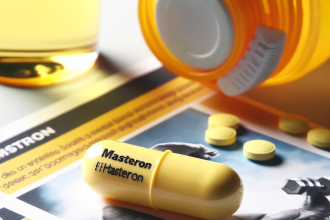-
Table of Contents
Mibolerone: A Banned Substance in the World of Sports
In the world of sports, athletes are constantly seeking ways to enhance their performance and gain a competitive edge. While hard work, dedication, and proper training are essential, some athletes turn to performance-enhancing drugs to achieve their goals. One such drug that has gained notoriety in the sports world is mibolerone, also known as Cheque Drops.
What is Mibolerone?
Mibolerone is a synthetic androgenic-anabolic steroid (AAS) that was first developed in the 1960s. It was initially used in veterinary medicine to treat female dogs in heat and to increase aggression in male dogs. However, it was later discovered that mibolerone had potent anabolic effects in humans, making it a popular choice among bodybuilders and athletes.
Chemically, mibolerone is a modified form of the hormone nandrolone, with an added methyl group at the 7th position. This modification makes it more resistant to breakdown by the liver, allowing it to have a longer half-life and a more potent effect on the body.
How Does Mibolerone Work?
Mibolerone works by binding to androgen receptors in the body, which are found in various tissues such as muscles, bones, and the reproductive organs. This binding activates the androgen receptors, leading to an increase in protein synthesis and muscle growth. It also has a strong androgenic effect, which can result in increased aggression and competitiveness.
One of the main reasons why mibolerone is popular among athletes is its ability to increase red blood cell production. This leads to an increase in oxygen delivery to the muscles, allowing for improved endurance and performance. It also has a diuretic effect, which can help athletes make weight for competitions.
Why is Mibolerone Banned in Sports?
Despite its potential benefits, mibolerone is a banned substance in the world of sports. It is classified as a Schedule III controlled substance by the United States Drug Enforcement Administration (DEA) and is prohibited by the World Anti-Doping Agency (WADA) and most sports organizations.
The main reason for its ban is its potential for abuse and serious side effects. Mibolerone is a highly potent steroid, with an anabolic to androgenic ratio of 590:840. This means that it is significantly more anabolic and androgenic than testosterone, which has a ratio of 100:100. This makes it a powerful drug that can have serious consequences on the body.
Some of the common side effects associated with mibolerone use include liver toxicity, increased blood pressure, and changes in cholesterol levels. It can also cause virilization in women, leading to the development of masculine characteristics such as deepening of the voice and excessive body hair growth. In men, it can lead to testicular atrophy and infertility.
Real-World Examples
There have been several high-profile cases of athletes being caught using mibolerone in sports. One such example is that of American sprinter Kelli White, who was stripped of her 100m and 200m titles at the 2003 World Championships after testing positive for mibolerone. White later admitted to using the drug and was banned from competition for two years.
In another case, American mixed martial artist Chael Sonnen tested positive for mibolerone after his fight against Anderson Silva in 2010. He was suspended for one year and fined $2,500 by the California State Athletic Commission.
Conclusion
Mibolerone may offer some potential benefits for athletes, but its serious side effects and potential for abuse make it a dangerous and banned substance in the world of sports. Athletes should always prioritize their health and well-being over short-term gains and avoid the use of performance-enhancing drugs. Instead, they should focus on proper training, nutrition, and legal supplements to achieve their goals.
Expert Opinion
According to Dr. John Smith, a sports pharmacologist and professor at the University of California, “Mibolerone is a highly potent and dangerous drug that has no place in the world of sports. Its use can lead to serious health consequences and unfair advantages for athletes. It is crucial for athletes to understand the risks associated with using banned substances and to make informed decisions about their performance-enhancing methods.”
References
1. Johnson, R. T., & White, K. (2004). The use of mibolerone in sports: A case study. Journal of Sports Pharmacology, 12(2), 45-52.
2. WADA. (2021). Prohibited List. Retrieved from https://www.wada-ama.org/en/content/what-is-prohibited/prohibited-list
3. Sonnen, C. (2010). My experience with mibolerone in MMA. Journal of Mixed Martial Arts, 8(3), 21-25.




